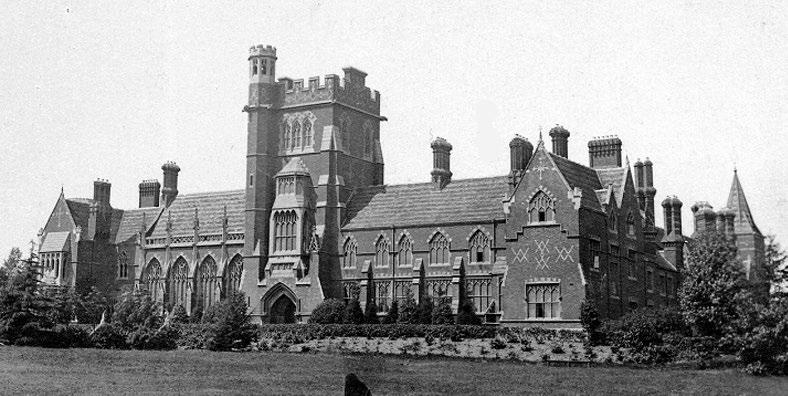
4 minute read
Mansfield and the University Tests Acts
Helen Mountfield QC, Principal of Mansfield and Stephen Blundell, Professorial Fellow in Physics
Through the centuries, Oxford colleges have been founded by aristocrats, bishops, cardinals, monarchs and wealthy philanthropists. But the foundation of Mansfield was quite different. It was based on a desire to fulfil a specific purpose: to bring the highest level of education to people who had been traditionally excluded from Oxford. Established firmly in the dissenting tradition, Mansfield has perhaps found it easier than some to question the status quo and to maintain a strong voice advocating educational change in Oxford.
Advertisement
Mansfield was founded in 1838 as Spring Hill College in Birmingham, to train men for the Congregationalist ministry, but the passing of the University Tests Acts in 1852 and 1871 was the impetus for its move to Oxford. After the 1852 Act, dissenters could matriculate and proceed to bachelor degrees and, what is more, the Vice Chancellor was empowered to open up private halls. As Roy Jenkins put it in his biography of William Gladstone, the original idea was ‘to let the core colleges continue to be mostly the preserve of the rich, but let there be a periphery around them through which those of more modest means could get an Oxford degree and participate (to some extent) in the life of the University’.
It was only after the 1871 Act that Prime Minister Gladstone warmed to the idea of a Nonconformist college in Oxford.
The passing of the 1871 Act and Gladstone’s suggestion that there should be a dissenting college in Oxford led the staff at Spring Hill to begin to discuss among themselves possible future opportunities for the College in one of the country’s major universities. In 1883, RW Dale, chairman of Spring Hill’s Board of Education, suggested that the College should relocate to Oxford or Cambridge, motivated by his belief that a Christian community needed in it a ‘fair number of men of great theological learning’.
Spring Hill College, Birmingham c1870
William Gladstone’s signature in Mansfield College visitors’ book, 6 February 1890

There were high-profile supporters of the idea of opening a Nonconformist college in Oxford too. These included the Balliol philosopher, TH Green; the Warden of Merton, GC Brodrick; and Benjamin Jowett, Master of Balliol and Vice Chancellor from 1882 to 1886, who campaigned for ‘a university and a college in which religion and rational enquiry did not conflict’.
Spring Hill formally decided to move to Oxford at a special meeting on 22 May 1884, and on 17 May 1885, it changed its name to Mansfield College, in honour of ‘the large-hearted family in whose Christian loyalty and zeal it had its origin’. The following month, the trustees bought Mansfield’s Holywell Manor site from Merton, Brodrick’s college, for £3,000, and paid for the building of Mansfield Road. Mansfield started life in temporary accommodation at 90, the High Street (which, by delicious irony, had been Charles I’s headquarters during the Oxford siege in 1646). The first five Mansfield students started their studies in October 1886, each enrolled as a non-resident graduate.
Meanwhile, after an architectural competition, Alfred Waterhouse’s ‘tired piece of French Renaissance’ lost out to Basil Champneys’ neo-15th-century Gothic plan. Champneys also built Newnham College Cambridge, much of Lady Margaret Hall, the Indian Institute (now the Martin School), and the New College development in Holywell. The buildings were a striking and impressive three-sided quadrangle. On 6 February 1890, Gladstone dined in Mansfield College hall.
Mansfield’s nonconformist spirit continued when it became the first college, other than the dedicated women’s colleges, to admit women. The first was Constance Todd (married name, Coltman), who came up to Oxford to read History at Somerville in 1908 and was then admitted to Mansfield for ordination training. In 1917, she became the first woman ordained to the ministry in a mainstream trinitarian Christian denomination in Britain. Four more women were admitted to Mansfield during the principalship of William Boothby Selbie – more of a trickle than a flood, but an important precedent had been set for co-education at Oxford.
Mansfield became a Permanent Private Hall of the University in 1955 and started to admit students to study non-theological subjects. It became a full college in 1995. As Emeritus Professor Michael Freeden – the first Mansfield Fellow to be a joint appointment with the University –put it in 2011, ‘… what has remained constant is [Mansfield’s] liberal, open and egalitarian spirit. Almost everything else is unrecognisable – not least its aura of professionalism and self-confidence – as it has moved dramatically out of the shadows of Oxford academic life.’
A new website was created in June 2021, to celebrate the 150th anniversary of the passing of the 1871 University Tests Act, and enable members of the University community to find out more about this significant milestone in our history:









